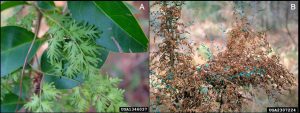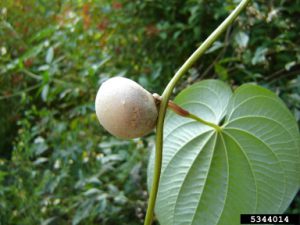By Dr. Candice Prince, UF/IFAS Center for Aquatic and Invasive Plants & UF Agronomy Faculty
A common joke in Florida is that only has two seasons: hot, and hotter. Tourists flock to the state during the winter months to escape freezing temperatures and bask in the sunny, idyllic weather. However, while it’s true Florida winters are pleasantly mild for people, the seasonal changes in temperature, rainfall, and day length can be quite dramatic for plants.
Many life events for a plant – such as flowering, fruiting, or dropping their leaves – occur on a seasonal calendar. The science of looking at the timing of these events is called “phenology”. Plant phenology helps people plan crop production for agriculture, prepare for allergy season, and understand important processes in natural areas.
This can be especially important when thinking about invasive plants (non-native species that spread into natural areas and cause environmental and/or economic harm). Knowing what time of year an invasive plant will be growing, reproducing, or entering dormancy, makes it is easier to understand how it affects our native species. Having this information also assists in planning management more effectively throughout the year.
So, what are invasive plants doing during the winter months in Florida? Many species grow more slowly during the cold months. Their metabolism slows down, and in northern parts of the state some species may die back or drop their leaves, entering a period of dormancy.

Image credit: A) Chris Evans, University of Illinois, Bugwood.org; B) James H. Miller, USDA Forest Service, Bugwood.org
For example, Japanese climbing fern (Lygodium japonicum) fronds may change color and die back in the winter if there is a frost. Vines that die back create a trellis for new plants in the spring and summer. Hydrilla (Hydrilla verticillata), an aquatic invasive plant, may also slow its growth. Hydrilla can die back in northern parts of Florida and temperate regions outside of the state. However, it is important to keep in mind many species, such as hydrilla, can grow year-round in south and central Florida where the temperatures remain warm.

Image credit: Karen Brown, University of Florida, Bugwood.org
Air potato (Dioscorea bulbifera) is an invasive vine that has a dormant period during the winter. Although its vines die back aboveground, the plants survive underground as tubers and regrow during the spring. Air potato vines also produce aerial tubers called bulbils. These tubers drop to the ground when the vines die back, and sprout during the spring to form new air potato plants.
Air potato is a great example of how management of species can also change during the winter. For example, the bulbils are easy to hand-remove during wintertime because there is less vegetation. In fact, cities often host “air potato roundups” to help control the plant. Another management technique for this plant is the air potato leaf beetle. This beetle serves as a biological control of the plant species. The beetles eat the leaves of air potato plants, so when the plants lose their leaves during the winter the adult beetles are left without a food source. They bury themselves in leaf litter and undergo an inactive period called diapause, reemerging in spring once the vines begin to grow.
Dr. Candice Prince, UF/IFAS CAIP and UF Agronomy Faculty, wrote this piece. Any questions should be directed to Shelby Oesterreicher at 352-273-3667 or soesterreicher@ufl.edu. For more information about the UF/IFAS Center for Aquatic and Invasive Plants, please visit https://plants.ifas.ufl.edu. Be sure to follow us on social @UFIFASCAIP.
UF/IFAS CAIP, Turning Science Into Solutions.
 0
0
